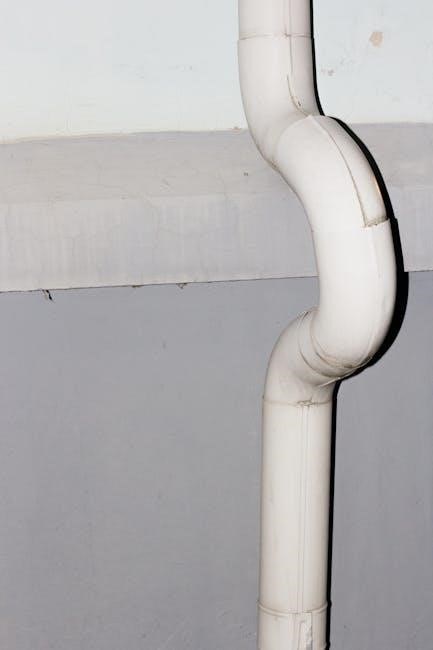The pipe diameter flow rate chart pdf provides information on flow rates and friction head losses for various pipe sizes and materials, including plastic PVC and polyethylene pipes, in imperial and metric units.
Understanding the Importance of Pipe Diameter and Flow Rate
The relationship between pipe diameter and flow rate is crucial in various industries, including water supply, sewage, and industrial processes. A larger pipe diameter can accommodate higher flow rates, while a smaller diameter restricts the flow. The pipe diameter flow rate chart pdf helps engineers and technicians determine the optimal pipe size for a given flow rate, taking into account factors such as friction head loss and velocity. By understanding the importance of pipe diameter and flow rate, professionals can design and install efficient piping systems that minimize energy losses and ensure reliable operation. This knowledge is essential for maintaining public health, safety, and environmental protection. Effective pipe sizing also reduces costs associated with energy consumption, pumping, and maintenance. The chart provides a comprehensive guide for selecting the right pipe size and material to achieve the desired flow rate, making it an indispensable tool in the field. Proper pipe sizing is critical to prevent issues.

Flow Rate and Friction Head Loss for Tubing and Pipe Sizes
Tables list flow rates and friction head losses for tubing and pipe sizes in imperial units.
Imperial and Metric Units for Pipe Size Charts
The pipe diameter flow rate chart pdf includes tables in both imperial and metric units, allowing users to easily reference and calculate flow rates and friction head losses for various pipe sizes and materials.
Imperial units are commonly used in the United States, while metric units are used in most other countries, so having both units available in the chart is convenient for users worldwide.
The imperial unit tables list flow rates in gallons per minute and friction head losses in feet per hundred feet of pipe, while the metric unit tables list flow rates in liters per minute and friction head losses in meters per hundred meters of pipe.
This dual-unit approach makes the chart a valuable resource for engineers, contractors, and other professionals working with pipes and fluid flow systems, regardless of their location or preferred unit of measurement.
The inclusion of both imperial and metric units also facilitates communication and collaboration between teams and organizations working on international projects.
Using Pipe Size Charts for Various Flow Rates
Charts help determine suitable pipe sizes for different flow rates and applications, ensuring efficient fluid flow and minimizing losses, with data organized by pipe diameter and flow rate.
Locating the Number Along the Bottom of the Chart
To determine the size of the pipe and flow rate, it is essential to locate the number along the bottom of the chart, which represents the flow rate in gallons per minute (GPM) or liters per minute. This step is crucial in identifying the correct pipe size and flow rate. The chart typically lists the flow rates in ascending order, making it easier to find the desired flow rate. Once the flow rate is located, the user can proceed to the next step, which involves locating the flow rate in GPM demand along the left side of the chart. The intersection of these two points will provide the necessary information to determine the pipe size and flow rate. By following these steps, users can accurately determine the pipe size and flow rate, ensuring efficient fluid flow and minimizing losses. The chart provides a comprehensive guide for pipe sizing and flow rate determination.

Determining the Size of the Pipe, Velocity, and Friction Loss
Use charts and formulas to determine pipe size, velocity, and friction loss accurately always.
Steps to Determine the Size of the Pipe and Flow Rate
To determine the size of the pipe and flow rate, follow specific steps. First, locate the number along the bottom of the chart, which represents the flow rate in gallons per minute. Next, locate the flow rate in GPM demand along the left side of the chart. Then, use the chart to find the corresponding pipe size and velocity. The chart provides a range of pipe sizes and flow rates, making it easy to determine the correct size of the pipe for a specific application. By following these steps, you can accurately determine the size of the pipe and flow rate, ensuring that your piping system functions efficiently and effectively. The chart is a valuable tool for anyone working with pipes and flow rates, providing a quick and easy way to determine the correct pipe size and flow rate.

HDPE Pipe Size Options and Minimum Pipeline Velocity
HDPE pipe size options include DR-17 and DR-11 with minimum pipeline velocities of 2.4 m/s and 8/sec for non-settling slurries and solids.
Flow Rate and Estimated Production Yards/Hour for HDPE Pipes
The flow rate and estimated production yards/hour for HDPE pipes are crucial in determining the pipeline’s efficiency. According to the data, HDPE DR-17 and DR-11 pipes have different flow rates and estimated production yards/hour. The flow rate is measured in gallons per minute (gpm) or meters per hour (m/hr). The estimated production yards/hour is calculated based on the flow rate and the pipeline’s velocity. The data shows that the flow rate and estimated production yards/hour vary depending on the pipe size and material. For example, HDPE DR-17 pipes have a higher flow rate and estimated production yards/hour compared to HDPE DR-11 pipes. The flow rate and estimated production yards/hour are essential in designing and operating pipelines, especially in applications where high flow rates and efficiencies are required. By using the correct flow rate and estimated production yards/hour, pipeline operators can optimize their systems and reduce costs. The data provided can be used to determine the optimal pipe size and material for a specific application. This information is critical in ensuring the pipeline’s efficiency and reliability. The flow rate and estimated production yards/hour for HDPE pipes are vital in the pipeline industry.
Calculation Equation for Flow Rate and Velocity of Fluid in Pipes
Equation uses Chezy coefficient and flow velocity to calculate flow rate and velocity of fluid in pipes accurately always.
Chezy Coefficient and Flow Velocity in Pipes
The Chezy coefficient is a key factor in calculating flow velocity in pipes, and it is used in conjunction with the flow rate to determine the velocity of the fluid.
The equation for flow velocity takes into account the Chezy coefficient, which is a measure of the roughness of the pipe and the viscosity of the fluid.
The Chezy coefficient is typically denoted by the symbol C and is usually expressed in units of distance per time.
In order to calculate the flow velocity, the Chezy coefficient must be known or estimated, and this can be done using a variety of methods, including experimentation and theoretical models.
The flow velocity is an important parameter in pipe flow, as it determines the pressure drop and the flow rate of the fluid.
The Chezy coefficient and flow velocity are related by the equation, and this relationship is critical in understanding and predicting pipe flow behavior.
By using the Chezy coefficient and flow velocity, engineers and designers can optimize pipe systems for a variety of applications.
This includes water supply systems, sewage systems, and industrial processes, among others.
The Chezy coefficient and flow velocity are fundamental concepts in fluid mechanics and are essential for designing and operating pipe systems efficiently and safely.
The equation for flow velocity is a powerful tool for analyzing and predicting pipe flow behavior, and it has numerous applications in a wide range of fields.
The Chezy coefficient is a critical component of this equation, and its accurate determination is essential for reliable results.

on Pipe Diameter Flow Rate Chart PDF
The chart provides essential information on flow rates, friction head losses, and pipe sizes, making it an indispensable tool for designing and optimizing pipe systems.
By using the chart, users can quickly and accurately determine the flow rate and friction head loss for various pipe sizes and materials.
This information is critical for ensuring the safe and efficient operation of pipe systems, and for minimizing energy losses and costs.
The chart is widely available online and can be easily downloaded and printed for reference.
Overall, the pipe diameter flow rate chart PDF is a reliable and convenient resource that can help professionals to design and operate pipe systems with confidence.
The chart is an important reference for anyone working with pipe systems, and its use can help to ensure the safe and efficient transportation of fluids.
The pipe diameter flow rate chart PDF is a valuable tool that can help to optimize pipe system design and operation.
